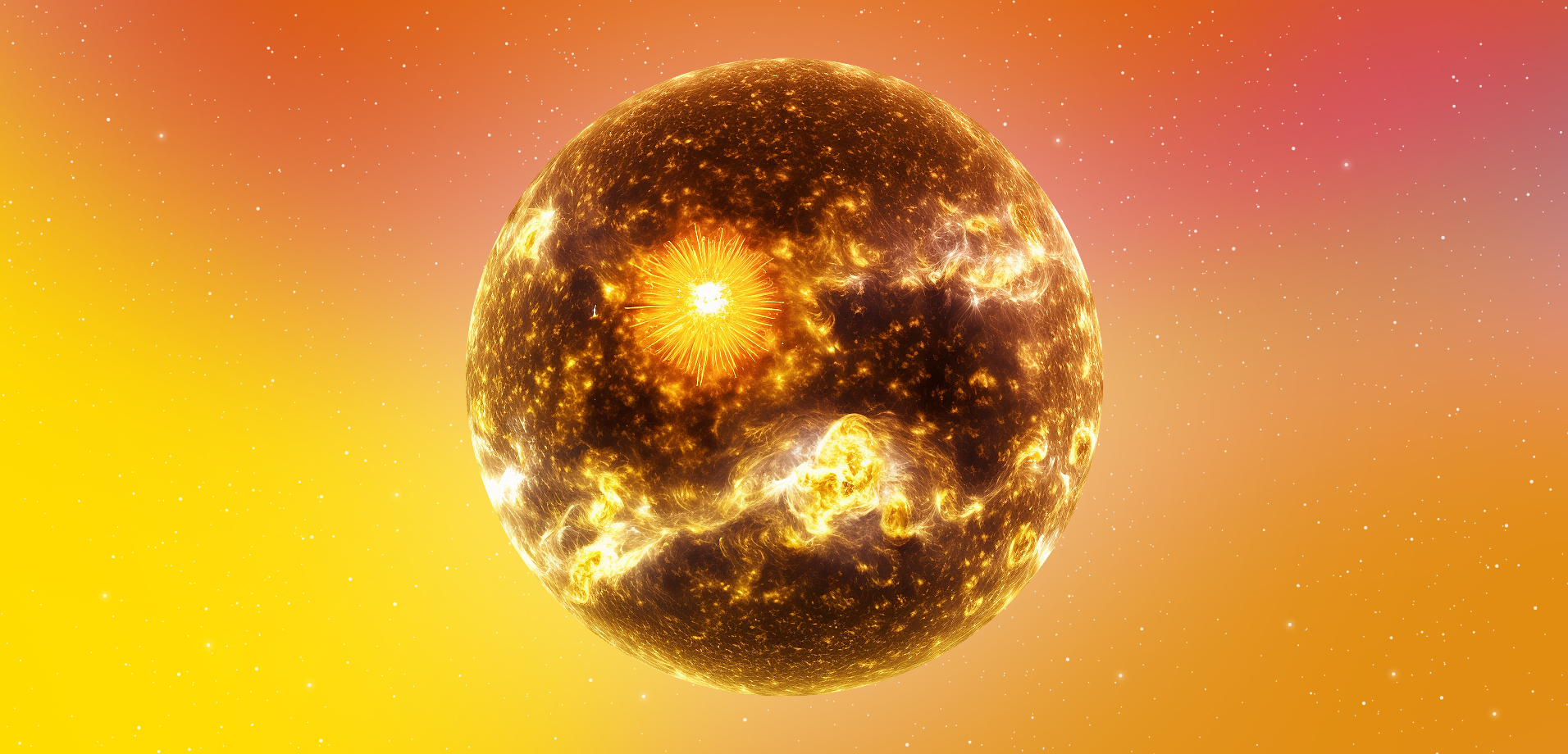How hot is the Sun exactly?
25th May 2023
We know firsthand how hot it can be in direct sunlight. Fortunately, we are protected by the Earth’s atmosphere and a decent distance from the star (93 million miles); otherwise, the fate of Mercury or Venus would have awaited our planet. But what will happen if the Sun suddenly heats up even more or, on the contrary, cools down? In this article, you will learn the answers to these questions, as well as what is the temperature of the Sun deep inside and on the surface, what does it depend on, how it affects the Earth, and is there anything hotter in space?
Hot but not killing
The Sun is one of the many stars in the Milky Way Galaxy and the only star in our solar system; it makes up almost 99.98% of the solar system’s total mass. It’s a huge sphere, with a diameter about 109x larger than the diameter of the Earth, and it consists mostly of hydrogen and helium. There are constant thermonuclear reactions with the release of huge amounts of energy, which is the main source of life on our planet.
By the way, the Earth is the only one of the solar system’s planets with an average temperature of 15 degrees Celsius. For comparison, on Neptune, the most distant planet from the Sun, it is minus 200 degrees Celsius, and on Mercury, which is closest to the Sun, plus 170 degrees. That is, if we were far from our star, we would turn into a block of ice, and if we were too close, its rays would burn out the oxygen in our atmosphere and kill all life. Seems unbelievable? Read about global warming and its threat to us. But as long as the temperature of the Sun doesn’t change and the Earth’s atmosphere stays intact (apart from the occasional ozone hole), we have nothing to worry about in that regard.
So, how hot is the Sun? The answer lies in the structure of the star, and it has a few surprises for us.
What is the Sun structure

The Sun is conventionally divided into inner and outer parts. The inner part consists of three layers:
- Core
- Radiative zone
- Convective zone
The outer zone is called the solar atmosphere and consists of:
- Photosphere
- Chromosphere
- Corona
- Prominence
Looking ahead, let’s say that each layer has its own temperature features. But let’s discuss everything in the right order.
What is the hottest part of the Sun?
That would be the core. The main, deepest, most gravitationally compressed part of the fireball is about 300-350 thousand km in diameter and about 150 times denser than water. In the core, a proton-proton thermonuclear reaction takes place, as a result of which helium is formed from four protons. At the same time, 4.26 million tons of matter are converted into radiation every second, and then this light takes about 40 thousand years to pass through all the layers of the Sun and reach the Earth. This makes the core the hottest part of the Sun, and the only one where heat and energy are generated. The remaining layers of the sphere are heated by this energy, so they have lower temperatures.
So, how hot is the Sun’s core? Its temperature reaches 28,000,000 degrees Fahrenheit, or about 15,000,000 degrees Celsius. Hot enough?
How hot is the radiation zone of the Sun?
The core is followed by a radiative zone. It is not as dense as the core, so sunlight travels through it with vast temperature fluctuations. The temperature difference in this zone ranges from two million on the surface to seven million degrees Celsius in depth.
How hot is the convective zone?
The next inner layer is a convective zone, which is located above the radiation layer and is of rather low density in comparison to it. In this zone, the core energy in the form of light is converted into heat. The mass of the convective zone resembles a seething fiery cauldron with bubbles that, when heated, rise to the upper edge of the zone, then cool down and fall to the hotter part of the layer. What is the temperature of the sun in this zone? This circulation of energy is called convection. By the way, its thickness is about 200,000 km, and when heated, hits as high as 5530°C.
How hot is the surface of the Sun?
The layer after the outermost inner layer is considered to be the first layer of the Sun’s atmosphere. It is called the photosphere or the surface of the Sun. It is in this area that the energy is cooled, and we see white light emanating from the Sun. Using eye-protecting devices, we can see everything through the photosphere. The temperature in the photosphere reaches 10,000°F or 5800°C. This is the generally accepted Sun surface temperature.
How hot is the chromosphere of the Sun?
The photosphere is followed by a chromosphere with a height of 2000 km. And attention! The temperature of this layer is higher! In the chromosphere, the Sun’s temperature is about 36,032 degrees Fahrenheit, or 20,000 degrees Celsius, respectively; also, the colour is red and not white, like the photosphere. The chromosphere can be observed during a total solar eclipse in the form of red flashes.
How hot is the halo of hot gas surrounding the Sun?
The next final atmospheric layer of the Sun is the corona. But between the corona and the chromosphere, there is a small layer — the transition region. It is notable for the fact that the temp of the Sun is rapidly increasing here.
The corona is eclipsed by the light of the Sun’s surface (photosphere), but it can still be seen during a total solar eclipse. Corona features are as follows:
- distance of approximately 25,000 km from the surface of the Sun;
- rarefied medium with a very low density — lower than the density of water by 1 billion times;
- consists of plasma;
- the temperature here is from 1.8 million to 3.6 million degrees Fahrenheit;
- the temperature in Celsius is 1-2 million degrees.
How hot is the halo around the Sun and why is it hotter than the visible layers?
If we analyse the temperature of the layers, we will notice a few interesting facts. Moving away from the core, the temperature drops, so it would be logical if the outermost shell had the lowest temperature. But in practice, it is not so. The temperature drops only until the chromosphere, and then it begins to grow rapidly. In the corona, the temperature is 500 times higher than on the surface of the Sun. Scientists have no explanation for this now, so this phenomenon remains yet another unsolved cosmic mystery.
Do we have anything hotter than the Sun?
So, we have found out that the Sun is very hot. But what is hotter than the Sun? Let’s compare it with some phenomena on Earth and other stars.
What is hotter lava or Sun?

Fiery hot lava erupting from awakened volcanoes seems to be the hottest phenomenon on Earth. How hot is lava compared to the Sun? Indeed, the molten rock is very hot, and its temperature can reach 2200°F or 1200°C. But it is much lower than the outer layers of the Sun temperature, not to mention its core and corona. And yet, there are Earth phenomena that are hotter than the surface of the Sun — for example, lightning.
How hot is lightning compared to the Sun?

Lightning along the coast near Little Sur River in Big Sur, Calif. on August 16, 2020. Image Credit: Kodiak Greenwood. Special To The San Francisco Chronicle
Technically, lightning is the movement of electrical charges and has no temperature; however, the resistance to the movement of these electrical charges causes the materials through which the lightning passes to heat up.
If the object is a good conductor of electricity, it will not get too hot. However, air is a very poor electricity conductor. That is why lightning can heat the air up to 50,000 degrees Fahrenheit (which is five times hotter than the surface of the Sun).
How hot is the Sun compared to other stars?

There is no object hotter than the Sun in the solar system. But the universe contains millions of other stars of different sizes and colours. Based on these data and the stars’ spectral types, scientists distinguish seven classes of stars by temperature. They are designated by letters: O, B, A, F, G, K and M. Class O and B stars are the hottest and emit blue light. How hot is a blue star compared to the Sun in degrees Celsius? The blue star’s temperature is 25,000 °C versus 5800 °C of the Sun’s surface.
Class M celestial bodies are the coldest stars that glow red. Want to know how hot is the coldest Sun? The coldest stars have a temperature of almost 5000°F or 3800°C.
In between the hottest and coldest stars, scientists distinguish:
- whites ones with a temperature of 17,500°F or 9730°C;
- yellow ones with a temperature of 10340°F or 5730°C, including our Sun;
- orange ones with a temperature of about 7000°F or 3700°C.
As we can see, the Sun is far from the hottest star in the Universe; blue and white stars are ways hotter. But even this is not the limit.
What is the hottest thing in the Universe?

To date, scientists know about two phenomena in the Universe that they call the hottesy, surpassing the Sun in temperature many times over:
- Supernovae — their temperature reaches a million degrees Celsius. These explosive events occur when a star 8 to 40 times more massive than our Sun reaches the end of its stellar life cycle and explodes after its core collapses. The Kepler supernova explosion of 1604 was the last major supernova event observed directly from Earth. On average, supernova explosions occur in the Milky Way three times in one century.
- Star WR 102 Wolf-Rayet in the constellation Sagittarius at a distance of 8480 light-years from Earth. This is a member of rare class stars, which is about 380,000 times brighter than our Sun and sixteen times more massive. Its surface temperature is 210,000°C, which approaches the temperature of a supernova explosion.
Conclusion
No matter how hot is the Sun, it is the main source of life on Earth. Without its radiation, our planet would not be as beautiful and hospitable as it is. According to scientists, the reserves of this energy will suffice for tens of millions of years. Find out what will happen to the Sun later in our article on Sun age.







Thank you for your comment! It will be visible on the site after moderation.